Menu
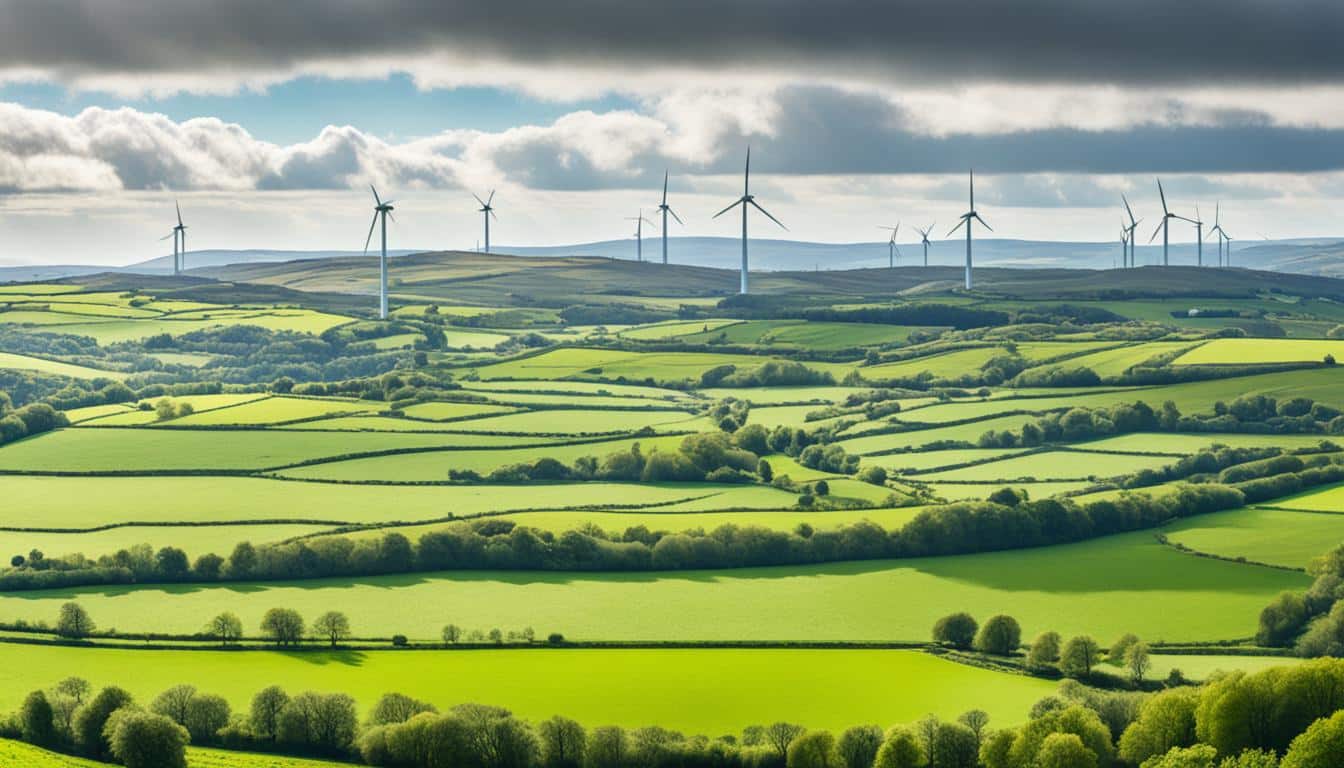
Ireland is aiming to slash its greenhouse gas emissions by 51% by 2030. It wants to reach net zero emissions by 2050. The Climate Action and Low Carbon Development (Amendment) Act 2021 makes this possible. It is leading the way in Europe for strict environmental laws.
This new law doesn’t just affect the government. It calls on everyone, especially those in farming, to do their bit. It requires more eco-friendly ways of farming. So, farmers will need to change how they work. This includes managing carbon better and using new support resources.
A big change is the introduction of carbon budgets by the Irish Government. These budgets limit the total amount of greenhouse gases allowed in certain times. They cover 40 areas, including agriculture. They lay out a plan for a green economy. Farmers must know and follow these new rules to keep farming sustainably.
The Ireland Climate Action Low Carbon Development Act is key for a greener future. It aims for a climate-resilient and neutral economy by 2050. This law requires new climate plans yearly. These plans set five-year goals and limits on how much we can pollute each year. They make sure we reach our big targets for 2030 and 2050.
This Act makes sure the Minister reports on our climate progress every year. The reports cover what we’re doing to lower our impact and cope with changes. They also check our pollution levels based on expert reports.
Every Minister in charge of a different area must report on how they’re helping the environment each year. These detailed reports keep an eye on pollution and suggest how we can do better. The joint committee can give tips on making these sector plans work, and Ministers must answer back in three months.
The Act doesn’t just talk about the plans. It also tells us what important terms mean and how to meet goals set by the EU. The aim is clear: a greener, safer home by 2050.
| Key Provisions | Details |
|---|---|
| Annual Climate Reporting | Mandated by the responsible Minister to report on the most recent climate action plan, covering policies, measures, and emission changes. |
| Five-Year Carbon Budgets | Established to ensure compliance with greenhouse gas reduction targets for 2030 and 2050. |
| Sectoral Emission Ceilings | Specific caps on emissions within various sectors to ensure collective progress towards national targets. |
| Joint Committee Reports | Recommendations on climate reporting matters reviewed and responded to within three months by Ministers. |
| EU Directives | Incorporates European Union directives relevant to implementing climate policies. |
The Act in Ireland targets climate change by changing how we farm. It aims to cut down negative effects and help the environment. To do this, farmers must change their methods to follow the new climate laws.
Farmers in Ireland must now farm in eco-friendly ways under the new law. They must use less chemical nitrogen and practice organic farming. It’s also important to manage dairy and beef emissions better to reduce harm to the environment.
Good practices include careful manure management and using better additives in animal feed. They are also asked to improve how animals graze.
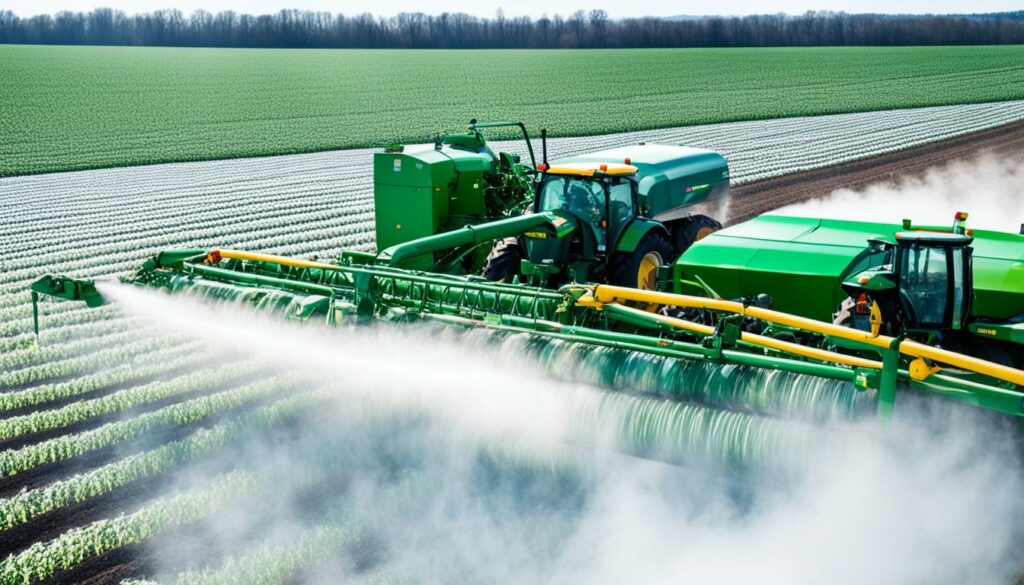
| Key Agricultural Changes | Expected Outcome |
|---|---|
| Reduction in Chemical Nitrogen Fertilisers | Lower Nitrous Oxide Emissions |
| Increased Organic Farming | Improved Soil Health and Biodiversity |
| Emission Management in Dairy and Beef Production | Decreased Methane Emissions |
The new climate law in Ireland offers great chances for farmers. They can now get into producing energy from renewable sources. This could include creating biogas or using solar power. Plus, planting more trees and forests lets farmers be part of carbon capture efforts, which helps the environment and brings in more money.
These steps help farmers deal with future environmental changes better. They ensure that farming can survive in the long term. By adopting these advanced methods, farmers will lead in eco-friendly farming in Ireland. This supports the country’s aim to have a low-carbon economy by 2050.
The Ireland Climate Action Low Carbon Development Act outlines a detailed plan. This plan uses carbon budgets and sectoral emission ceilings to lower greenhouse gases. It’s crucial for meeting Ireland’s climate goals.
Carbon budgets limit the amount of greenhouse gases Ireland can produce over five years. They aim for big cuts, like a 51% emissions drop by 2030. They also aim for zero emissions by 2050.
The Climate Change Advisory Council recommends these budgets. The government then approves them. This process helps manage emissions like we handle money. It sets clear goals for us to follow.
Each sector of Ireland’s economy has its own emission ceiling. This makes sure every part works on lowering its own emissions. Also, every Minister must share how well their sector is doing each year.
These updates talk about the achievements and challenges in lowering emissions. They also measure how well the sectors are sticking to their limits. And they discuss what’s being done to adapt. This way, everyone keeps working towards the main goal together.
The Climate Change Advisory Council (CCAC) is key in Ireland’s fight against climate change. As an independent group, it offers expert advice to the government. It ensures that plans for the environment match Ireland’s strong push for climate action.
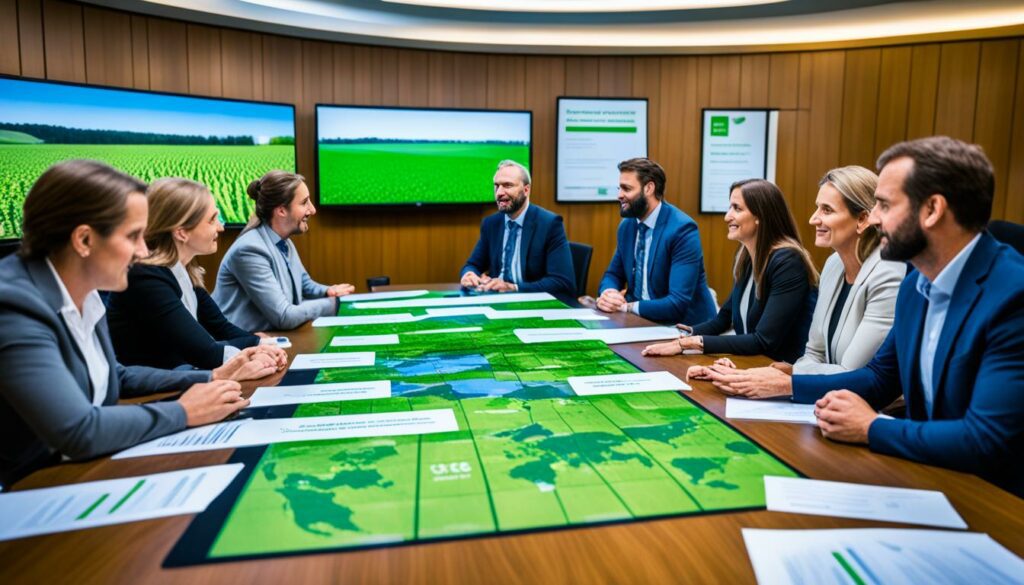
The CCAC suggests carbon budgets. The initial aims are to cut 51% of greenhouse gas emissions by 2030. This goal starts from 2018. These steps help to set clear targets for different sectors to reach Ireland’s climate goals.
It uses the Environmental Protection Agency’s information and expert analysis. They guide Ireland’s move towards a green, low-carbon economy. This is especially crucial as Ireland is legally bound to reach net-zero emissions by 2050.
Expert advice, strict legal rules, and making sectors accountable are the CCAC’s foundations. This approach is vital in reaching Ireland’s 2030 and 2050 climate targets. It moves Ireland towards a future where the environment is strong and sustainable.
The CCAC plays a big part in Ireland’s overall environmental plan. It marks a major step in Ireland’s journey to keep its climate promises.
The Ireland Climate Action and Low Carbon Development Act marks a new phase for farming. It provides various government aids for farmers. These include money incentives and training to shift to green methods.
The government is keying up efforts to push eco-friendly farming. It uses financial incentives to help with the costs of going green. For instance, farmers get support for growing food organically, reducing harmful fertilizers, and managing waste better. With the €165 billion National Development Plan, many of these issues are addressed to lighten the load on farmers financially.
| Type of Incentive | Description | Beneficiaries |
|---|---|---|
| Grants for Organic Farming | Financial support to increase land under organic cultivation. | All Farmers |
| Fertilizer Reduction Support | Monetary assistance for reducing chemical nitrogen use. | Crop Farmers |
| Waste Management Technologies | Funds to implement advanced waste management systems. | Dairy and Livestock Farmers |
Besides money supports, the government offers guidance and training. It wants farmers to have the know-how to work with the new laws. This training includes education on how to adapt to climate changes, sustainable farming methods, and clean energy. The aim is for farmers to not just follow the rules but to also do well in a world that values climate protection.
The whole aid system shows the government is serious about reaching its green goals. And it’s doing this without ignoring the needs of farmers. By using government support for farmers, Ireland hopes to make its farming sector a beacon of eco-friendliness and strength for the future.
The Ireland Climate Action and Low Carbon Development Act, 2021, set out a bold path. It aims for a future where Irish farming is kind to the climate and supports more wildlife. The act aims at a switch to a green economy while keeping farming strong and successful. It does this by promoting practices that fight climate change, protect nature, and aim to reach zero net emissions by 2050.
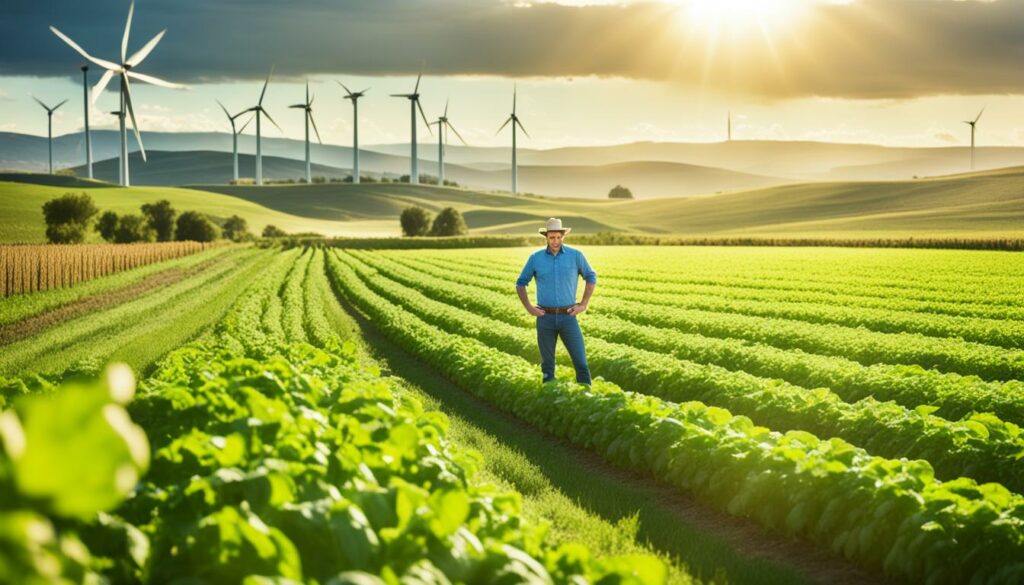
The Act focuses on using clean energy in farming. It suggests that farmers use solar panels and wind turbines. These steps cut down on harmful gases from farming and help Ireland meet its emission reduction goals. By doing so, farmers play a big part in keeping our planet healthy.
The Act also underscores the need to protect wildlife. It encourages farmers to grow trees and use other methods that boost biodiversity. These steps make farming more sustainable and able to handle climate changes. Ireland’s ambition is to be a place where nature thrives alongside farming to support a greener future.
The Climate Action Plan has set big goals for renewable energy in farming. This means farms will soon shift to more sustainable practices. They will start using solar energy farming and wind power agriculture more. This helps cut down on the use of harmful fossil fuels.
Choosing solar energy farming and wind power agriculture can really change farming for the better. Thanks to schemes like the micro-generation support, farmers get help to put up solar panels and wind turbines. These moves not just save money but also let farmers sell extra power. This is good for their pockets and the planet.
Using more renewable energy fits the country’s renewable energy goals. It cuts down on the gases that cause climate change. Farms can switch from fuels like diesel to solar and wind power. This means much less greenhouse gas from farm operations.
Ireland is aiming to cut greenhouse gases by 2030 and be carbon neutral by 2050. The Climate Action Plan sees big chances for organic farming to grow. It plans to increase the land for organic farming five times its current size.
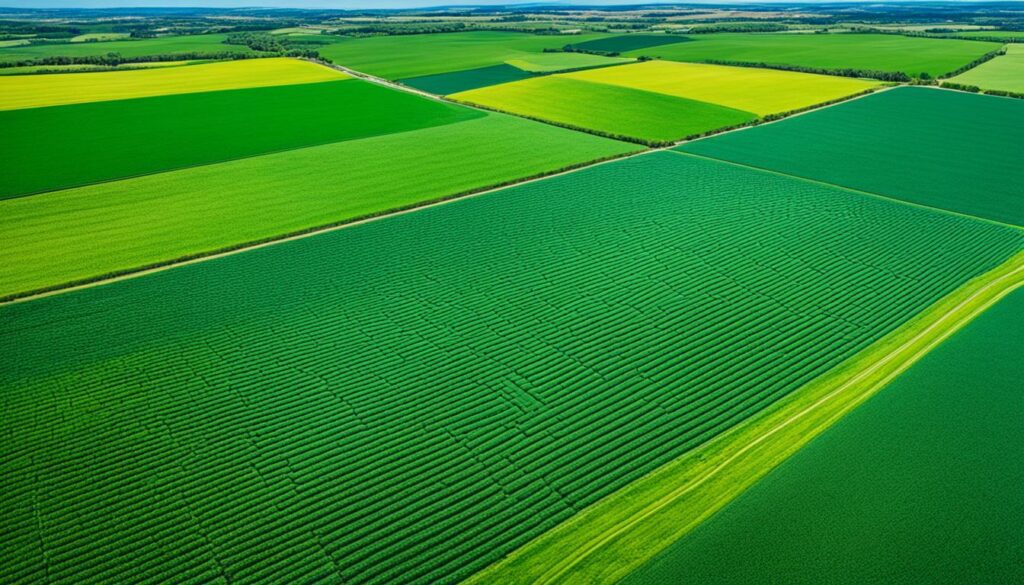
The plan wants to grow organic farming land to 350,000 hectares. This supports the goal of using less chemical nitrogen and lowering farm emissions. Changing to organic farming is a big but rewarding step for the farming world. It helps the environment, improves the soil, and protects wildlife.
Government rules and help are in place to boost organic farming. Farmers get guidance, certifications, and financial support for this change. This ensures a smooth switch to organic methods.
| Goal | Current | Target |
|---|---|---|
| Organically Farmed Land | Approximately 70,000 hectares | 350,000 hectares |
| Reduction in Chemical Nitrogen Fertiliser | Baseline Use | Significantly Reduced |
| Biofuel Use in Transport | Baseline Use | Increased |
| Electricity Emissions Reduction | Baseline Emissions | 62%-81% Reduction from 2018 Levels |
The nation’s focus on organic growth helps with climate goals while creating good farming opportunities. With the right support, farmers can do well in organic farming. They meet standards, look after the earth, and enjoy the benefits of organic farming.
The Climate Action and Low Carbon Development Act focuses on biodiversity conservation and good land management. It aims to cut down on carbon emissions. This helps improve biodiversity and encourage sustainable land methods.
A big part of the plan is to plant more trees. By growing forests, we capture carbon and boost biodiversity. This creates new homes for wildlife and helps keep the land sustainable.
Managing grasslands and peatlands is also key. By looking after these areas well, we make the most of the land. This is important for saving different species. It also helps with capturing carbon, fighting environmental issues, and making our climate more stable.
These efforts aim to help Ireland cut down on carbon in a smart way. It also supports caring for the land better. Together, this leads to a healthier and sustainable environment.
Farmers need to prepare for erratic climate trends more than ever. With the Climate Action and Low Carbon Development (Amendment) Act 2021 in Ireland, there are new guidelines. These focus on making farming better able to handle climate changes. By using these strategies, farms can keep producing well and be ready for nature’s challenges.
The act aims to make farming more resilient. It suggests using various farming methods that can adjust to changing climates. For example, farmers should mix up the types of crops they grow each season. They should also look after the soil carefully. These steps help in many ways, like getting more food from the land and keeping the soil healthy for a long time.
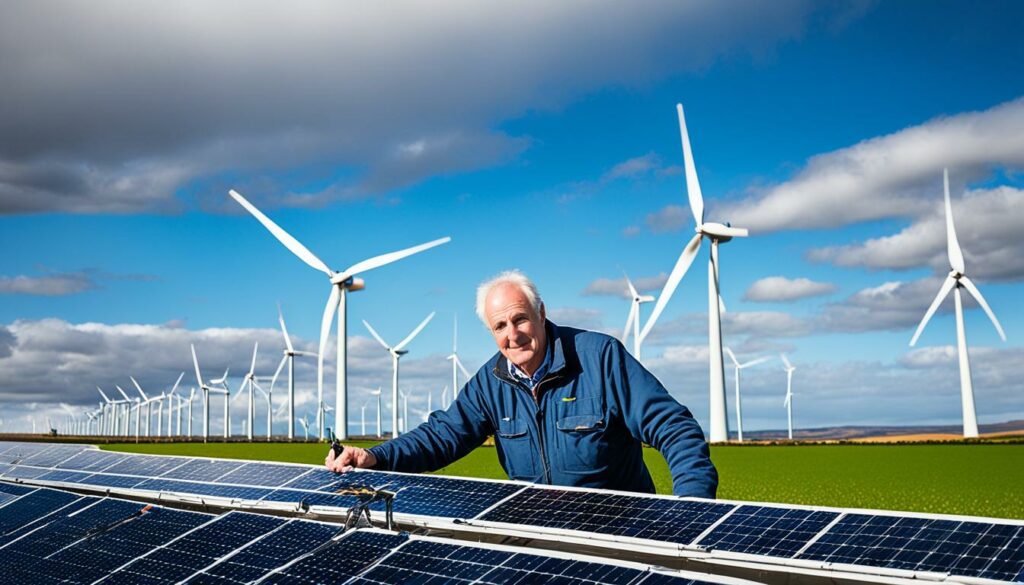
One major goal is to make farms less affected by extreme weather. Experts suggest breeding plants and animals that can better survive droughts, floods, and other severe conditions. Doing this can lower the harm caused by bad weather. It also supports the act’s aim of keeping farming strong, despite the changing climate.
The Minister for Agriculture gives annual updates on how well these strategies are working with regard to the latest climate action plan. These reports look at changes in how much greenhouse gases are produced. This oversight makes sure efforts to improve farming’s resilience are both effective and lasting.
| Climate Adaptation Strategy | Key Focus Areas | Expected Impact |
|---|---|---|
| Varied Crop Rotation | Diversifying crops to reduce reliance on single species | Enhanced soil fertility, increased resistance to pests and diseases |
| Advanced Soil Management | Implementing sustainable soil practices | Improved water retention, reduced erosion, better nutrient cycling |
| Breeding Techniques | Developing weather-resistant crop varieties and livestock | Decreased vulnerability to droughts, floods, and extreme weather conditions |
The Ireland Climate Action Low Carbon Development Act impacts the agricultural sector. It introduces a carbon tax affecting farm finances. Nevertheless, it offers ways to support farmers in adopting eco-friendly methods.
A carbon tax is put in place to lessen greenhouse gases. It charges for emitting carbon. This move pushes farmers towards sustainable ways. But, it’s a challenge for those using a lot of fossil fuels.
The government provides help to deal with the carbon tax hit. This comes in the form of cheap loans for green farming. The loans are part of a plan to make the shift lighter on farmers’ wallets.
There are also limits on emissions for 40 sectors in Ireland. The carbon tax supports the country’s 2050 goal for a climate-friendly economy. It tells farmers to help reduce greenhouse gases by 51% in 2030.
Farmers are key to Ireland’s work on its national climate goals. In 2019, 35% of the country’s emissions came from farming. They work hard, not just changing how they farm, but also encouraging others to care for the environment.
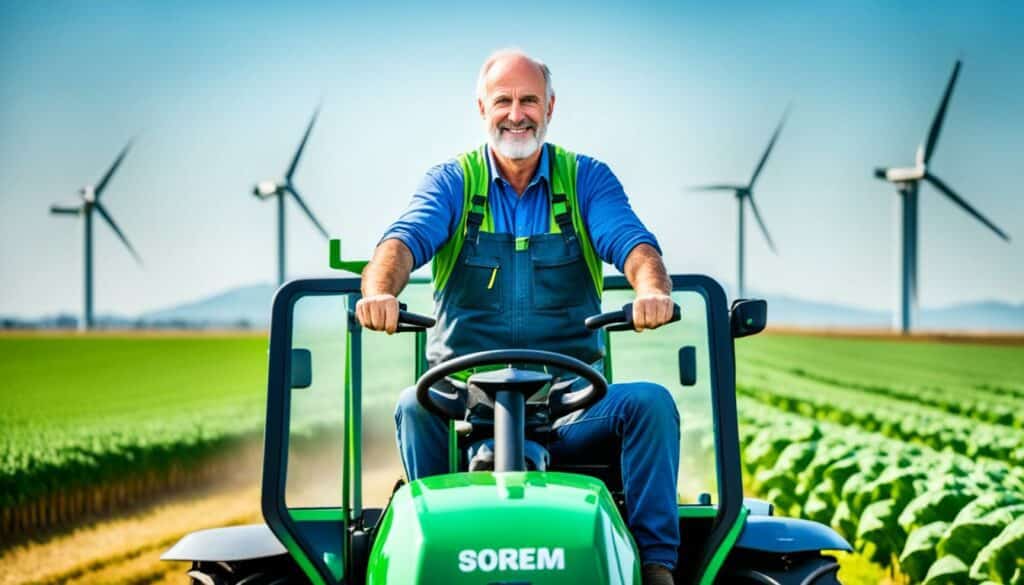
It’s important that farmers lead in making the climate better. By being the first to use eco-friendly methods, they show others how it’s done. They also work closely with their local communities to reach Ireland’s climate goals.
The Department of Agriculture has a plan that says farms must change now. When farmers and community leaders work together, they can make these changes happen faster.
In the big picture, farming sustainably is a must for Ireland to be carbon-neutral by 2050. Farmers are key to developing clean energy and ways to store carbon. They aim to cut down on harmful ammonia emissions by 99%.
With new methods like precision farming and better land management, farmers can help the EU cut emissions by 55% in 2030. These changes don’t just help the environment; they make farms more efficient and sustainable.
Farmers are the heroes pushing for a greener Ireland. They lead in farming that helps the environment and includes everyone. Their work is not just about fixing problems but aiming for a better future for all.
To meet Ireland’s bold climate targets, we must adopt sustainable farming methods. These methods cut down on harmful emissions. They use new strategies in breeding animals and growing crops.
Key to cutting the carbon from livestock is advanced breeding. This boosts cattle genes for better feed use. It lowers methane from their digestion.
Better feeds, like precise nutrition and supplements, also drop methane. They do more than cut emissions. They keep animals healthier and more productive, too.
Choosing the right crops and handling soil well are vital. They curb greenhouse gases. Picking crops wisely means less need for resources and shields against climate changes.
Methods like crop rotation and cover cropping boost soil. They lock up carbon and cut chemical use. Good soil practices help emissions go down. They also make farms better for the long run.
The Ireland Climate Action and Low Carbon Development Act of 2021 is a significant step for the nation. It paves the way for a future that is both sustainable and free of harmful climate effects. This new law aims to cut greenhouse gas emissions by 51% by 2030. Its ultimate goal is for Ireland to have net-zero emissions by 2050.
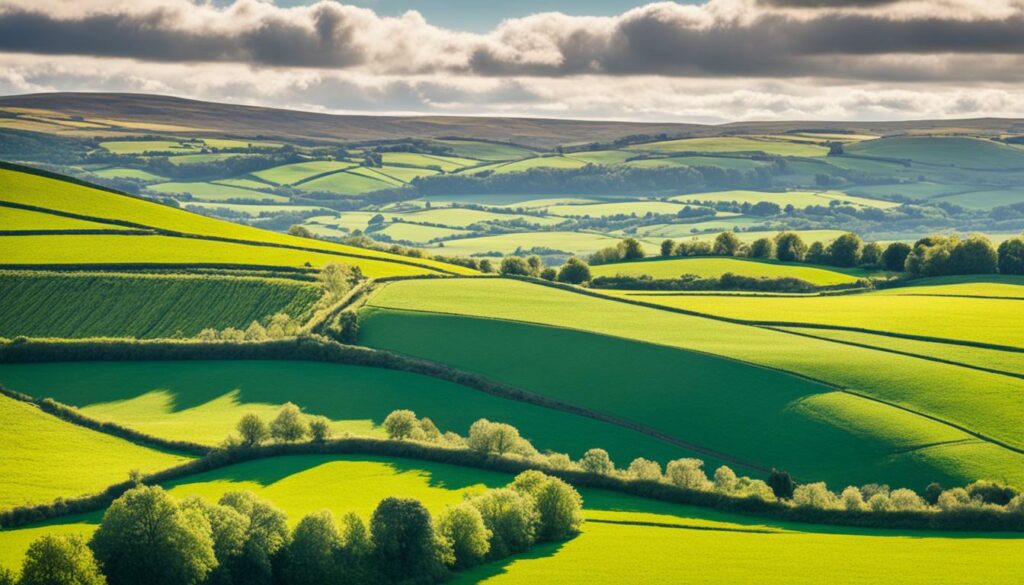
This Act introduces key legal measures to help reach its emission goals. For instance, it creates two sets of carbon budgets that must reduce emissions by 51% by 2030. Local councils must make Climate Action Plans that include ways to reduce emissions and deal with the effects of climate change. These plans are checked every five years. Public organisations must also follow these plans to ensure they help achieve the Act’s goals.
Local governments and organisations must stick to these tough rules. The Act makes sure of this by giving more power to the Climate Change Advisory Council. This council advises on important emission reduction plans. Government ministers also have a big role. They must update a parliamentary committee regularly on how they are doing with their emission targets. This helps keep an eye on progress and make sure everyone is doing their part.
Ministers must provide detailed updates on how every sector is reducing emissions and following the rules. A joint committee then checks these updates and can suggest improvements. Ministers have to act on these suggestions within three months. This ensures they are accountable and open about their work towards the Act’s goals.
This new law in Ireland shows how serious the country is about fighting climate change. It highlights a strong and cooperative effort to achieve a more environmental-friendly future.
The Ireland Climate Action Low Carbon Development Act is a big step for the country’s green goals. It aims to make Ireland’s economy low in carbon and tough against climate changes. This plan is designed to have Ireland produce less greenhouse gases. By 2030, the goal is to cut emissions by 51%. Eventually, they want to have no net emissions by 2050.
Farmers are central to this strategy. They look after the land and can lead in making these changes. With their help, Ireland can meet its environmental goals.
The Act uses carbon budgets and limits on how much each sector can emit. It ties in with the EU’s plan to be mostly carbon-free by 2050. This means everyone, including farmers, needs to be part of the solution. The Act encourages the use of new, less carbon-heavy tech to help Ireland’s economy stay green.
To fight climate change, Ireland has the National Adaptation Framework and Climate Action Plan. These plans help make Ireland more ready for the effects of climate change. They also help farmers by offering money, advice, and training to make their job more earth-friendly.
Promoting more plant and animal life and using more renewable energy are key parts of the Act. This shows the wide approach needed for a healthy climate future. Every farmer’s work is vital for Ireland’s nature and the world’s fight for a greener planet.
The Ireland Climate Action Low Carbon Development Act is designed to sharply cut greenhouse gas emissions. It aims to slash emissions by 50% by 2030. Its ultimate ambition is to hit net zero emissions by 2050, playing a key role in fighting climate change in Ireland.
The act aims to create a strong plan for a climate-friendly, sustainable economy by 2050. It includes making and updating climate action plans. Every five years, it sets how much carbon can be used. It also limits emissions from different industries.
The Act will change how farming is done. For example, it will reduce the use of chemical nitrogen fertilisers. It will encourage organic farming. And it will also focus on reducing emissions from dairy and beef production. These changes are important to reduce the farm’s impact on the environment.
There are many benefits for farmers. They can find new ways to make money, like in energy or planting trees. Diversification makes farms more adaptable. It helps them stand strong against changes like climate problems.
Carbon budgets are strict plans for how much greenhouse gas can be released. They cover five years. These plans are suggested by experts and then okayed by the government. Carbon budgets make sure everyone does their bit to cut emissions according to the national plan.
Sectoral emission ceilings put a limit on how much pollution each part of the economy can make. They ensure every part plays their role in reaching the emission reduction goals. This includes industries like agriculture.
The CCAC advises the government on what should be done to cut emissions. It is an independent group. Their advice helps set the limits on how much each industry can pollute. This advice is at the core of Ireland’s climate strategy.
The government helps farmers by giving them money and grants to make their farms greener. It also provides them with advice and training. This makes sure farmers have what they need to do well under the new rules.
The Act pushes for farms to use more solar and wind power. It aims to reduce the need for fossil fuels. By making this change, farms can make more money in different ways. This also helps meet Ireland’s goals for using more renewable energy.
The Act wants to see more land used for organic farming. It offers rules and support to make it happen. The goal is to make organic farming a big part of Ireland’s agriculture.
The Act encourages planting more trees and taking better care of grasslands and peatlands. This is good for protecting different kinds of plants and animals. It also helps keep the land healthy.
Farmers are advised to farm in ways that can handle extreme weather conditions. They should use smart crop choices and look after the soil well. These steps are important for keeping farms going for a long time.
The carbon tax will change how farming makes money. But there are plans to help, like social support and loans for green practices. These steps aim to make the change smoother for farmers.
Farmers are key in meeting Ireland’s climate targets. They can lead by example and encourage green ways. This will help reach Ireland’s goal of being free of harmful emissions.
The Act suggests better ways to breed animals and grow crops. It also points to looking after the soil as ways to lower emissions. These practices are important for a more sustainable, less polluting agricultural industry.
The Act has strict goals for cutting emissions by 2030 and going carbon neutral by 2050. It uses a strong advisory council, plans from local governments, and more checks by parliament to make sure these goals are met.